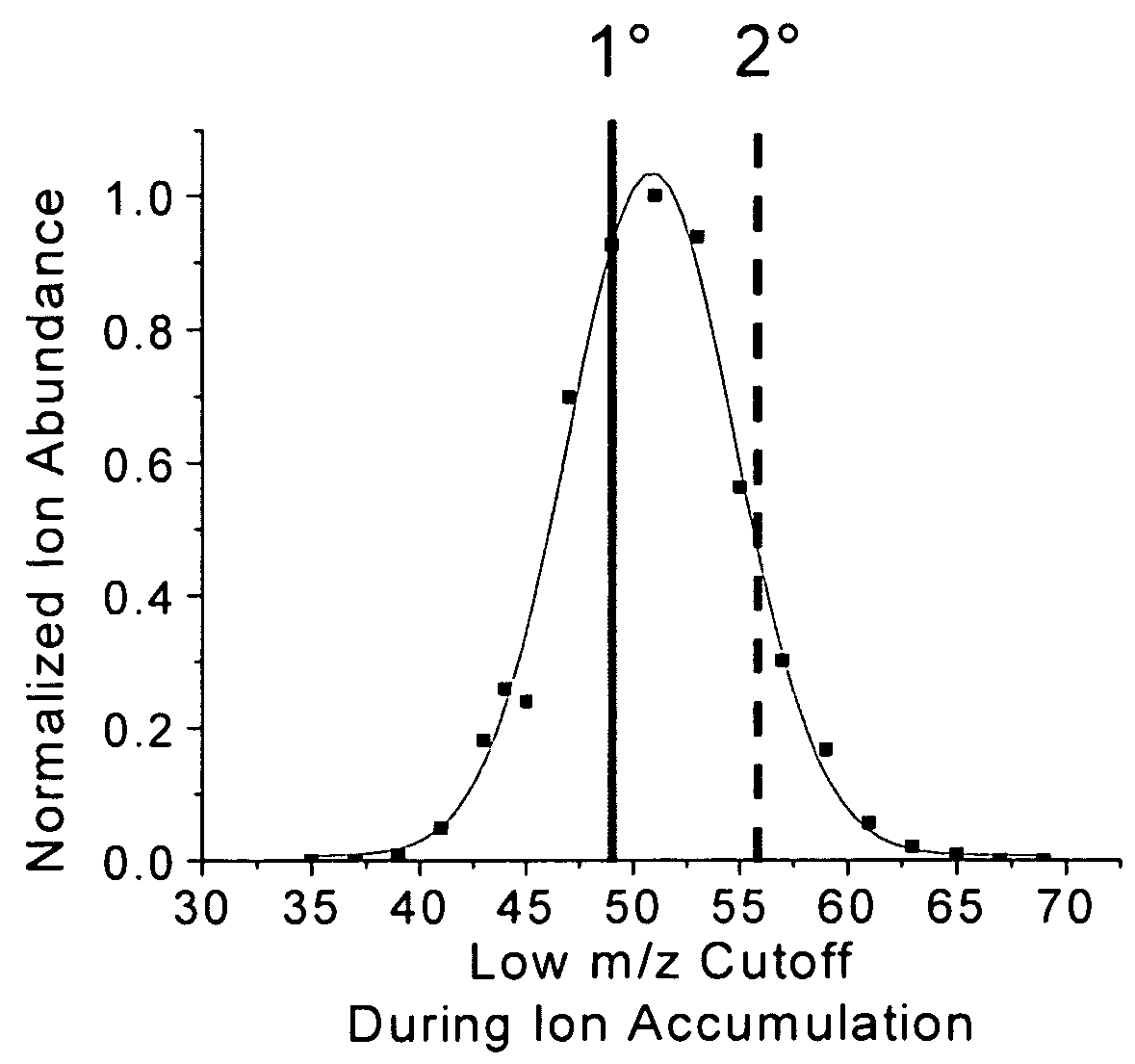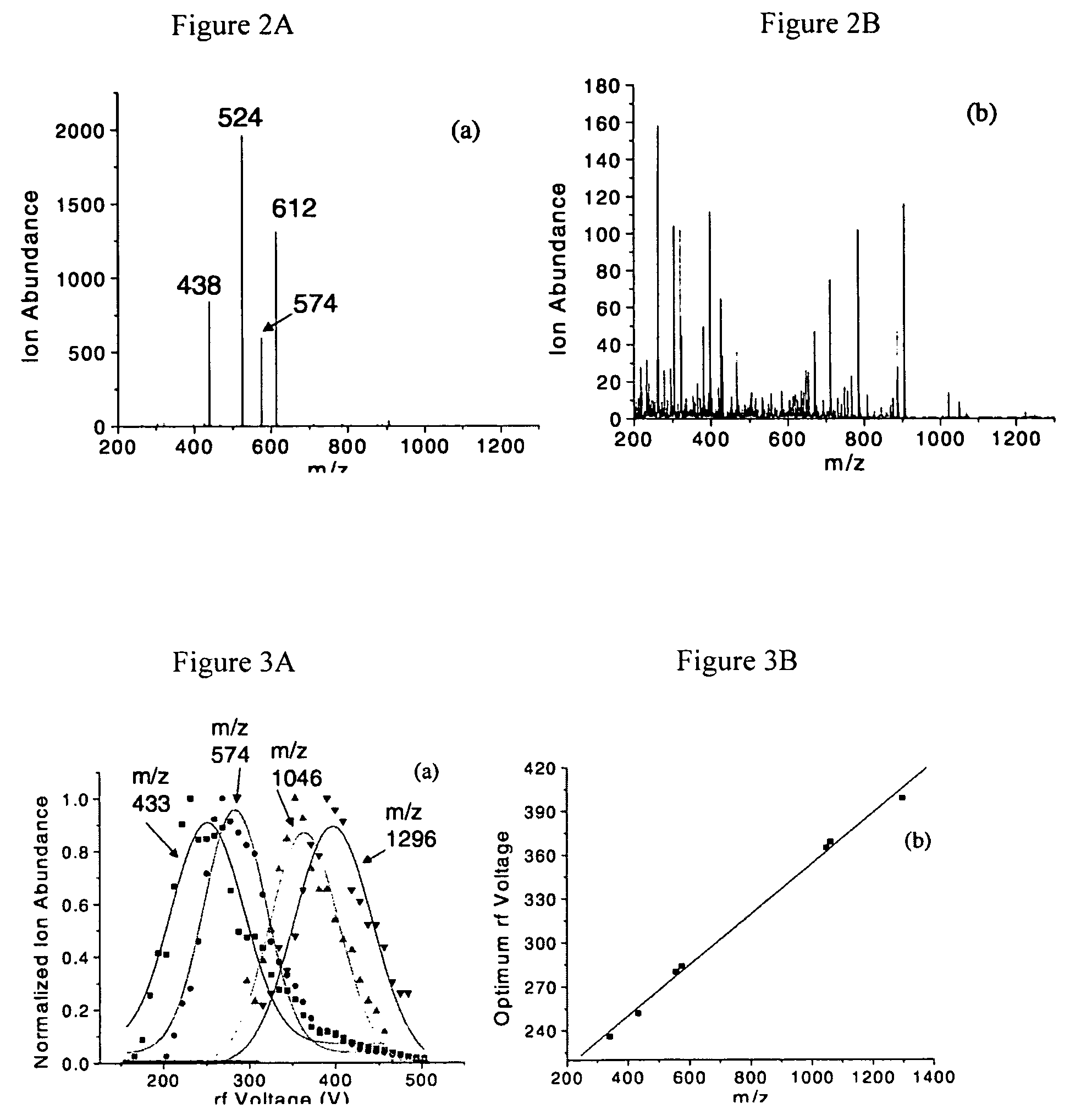Multiplexed tandem mass spectrometry
a tandem mass spectrometry and tandem mass spectrometry technology, applied in mass spectrometers, instruments, separation processes, etc., can solve the problems of ineffective methods, inability to fully realize the effect of mass-related bias, and inability to dissociate into product ions, so as to reduce mass-related bias, reduce mass-related bias, and avoid the inherent non-linearity
- Summary
- Abstract
- Description
- Claims
- Application Information
AI Technical Summary
Benefits of technology
Problems solved by technology
Method used
Image
Examples
example 1
[0057]As discussed above, a commonly considered disadvantage of quadrupole ion trap mass spectrometers is the limited and variable m / z range over which ions can be efficiently accumulated from external ion sources. This fact is illustrated in FIG. 4, which shows the mass spectra of the protein cytochrome c at two different rf accumulation voltages. In FIG. 4A cytochrome c charge states ranging from +15 to +20 are apparent when the rf voltage applied to the ring electrode during ion accumulation is such that the low m / z cut off (LMCO) is 41 Da, which corresponds to an rf voltage of approximately 257 Vp-p. When the rf accumulation voltage is increased to 320 Vp-p (LMCO=51 Da) during ion accumulation, the cytochrome c mass spectrum (FIG. 4B) clearly changes so that charge states between +13 and +18 are apparent. If the normalized ion intensity of the +15 charge state is plotted over a range of LMCO values, it is clear that a Gaussian distribution represents the relationship between ion...
example 2
[0058]A series of 16 peptide ions were studied to observe the relationship between ion intensity and the LMCO during ion accumulation. Just as in the preceding example, the distribution of ion intensity as a function of LMCO is also Gaussian in nature. Moreover, there is a linear relationship between the optimum LMCO during accumulation and peptide ion m / z, as illustrated in FIG. 6. The slope of this linear relationship differs for peptide ions with a +1 charge state as compared to peptide ions with a +2 charge state. For the +1 peptide ions, the equation for the line in FIG. 3 is y=0.024x+33.2, while for the +2 peptide ions the equation is y=0.045x+21.7. The width (at 50%) of the Gaussian distribution does not have any apparent relationship with peptide ion m / z as evidenced by FIG. 7. Within experimental error, the Gaussian widths (at 50%) appear to be about 8 Da. Both the Gaussian centers and widths are somewhat dependent upon the parameters used to transport the ions from the ele...
example 3
[0061]The data of Examples 3a-3e were acquired using a Bruker Esquire-LC quadrupole ion trap mass spectrometer. The following Esquire parameters were used for generation of the spectra. All parameters are subject to change depending on the compounds analyzed and corresponding experimental procedure. Some parameters vary slightly from day-to-day and are chosen to optimize a particular instrument response. These parameters are noted with and asterisk (*). The parameters noted with a plus sign (+) are optimally kept as constant as possible, as they appear to affect Gaussian width and center values, more so than others.
[0062]
*Capillary−3000V*End Plate Offset−500V*Nebulizer5psi*Dry gas3L / min*Dry temp.300C.+Skimmer 130V+Skimmer 210V+Capillary Exit Offset80V+Capillary Exit110V+Octopole2.70V+Octopole Delta2.50V*Octopole RF175V(p-p)*Lens 1−5V*Lens 2−60VMultiplier−1370VDynode−7kVScan Delay0.50msScan50 to 1650*Isolation Delay0msFragmentation Delay10msEsquire Isolation mass318 - approx qz 0.8+S...
PUM
 Login to View More
Login to View More Abstract
Description
Claims
Application Information
 Login to View More
Login to View More - R&D
- Intellectual Property
- Life Sciences
- Materials
- Tech Scout
- Unparalleled Data Quality
- Higher Quality Content
- 60% Fewer Hallucinations
Browse by: Latest US Patents, China's latest patents, Technical Efficacy Thesaurus, Application Domain, Technology Topic, Popular Technical Reports.
© 2025 PatSnap. All rights reserved.Legal|Privacy policy|Modern Slavery Act Transparency Statement|Sitemap|About US| Contact US: help@patsnap.com



